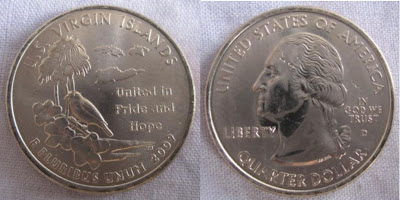Washington state quarter

The reverse of Washington's quarter features a king salmon breaching the water in front of majestic Mount Rainier. The coin bears the inscriptions "The Evergreen State," "Washington" and "1889."
Mount Rainier is an active volcano encased in more than 35 square miles of snow and glacial ice. It is the symbolic bridge between the eastern and western parts of the State. The salmon is another important symbol of Washington. It is a traditional image of Pacific Northwest culture, and this fish has provided nourishment for the native peoples of the Pacific Northwest.Every year thousands of salmon travel upstream against all odds and reach the source of the river where they mate and then die. The upstream journey is a very difficult one in which salmon fall prey to predators like bears and also make incredible jumps of several feet, and that too against the stream. Newsman and real estate pioneer C.T. Conover nicknamed Washington the "Evergreen State" because of its many lush evergreen forests.
Virgin Islands state quarter
 The U.S. Virgin Islands Quarteris the fifth release of the 2009 DC & US Territories Quarter Program. This program is a follow up to the popular 50 State Quarters Program to feature non-state jurisdictions of the United States.
The U.S. Virgin Islands Quarteris the fifth release of the 2009 DC & US Territories Quarter Program. This program is a follow up to the popular 50 State Quarters Program to feature non-state jurisdictions of the United States.The reverse design of the Virgin Islands Quarter features a bird known as the Banana Quit pictured next to the Yellow Cedar flower. Behind the bird is a Tyre Palm, a tree native to the Virgin Islands. The background includes an outline of the three main islands.
The Virgin Islands Quarter had a combined mintage of 82 million coins for circulation.The mintage was evenly divided between the Philadelphia and Denver Mint facilities.
Virginia state quarter
 The Virginia state quarter captures the scenic beauty of the State with its depiction of the New River and the New River Gorge Bridge. The coin bears the inscription "New River Gorge".
The Virginia state quarter captures the scenic beauty of the State with its depiction of the New River and the New River Gorge Bridge. The coin bears the inscription "New River Gorge".This coin also depicts the quadracentennial of the Jamestown settlement, which was the first successful English settlement in America in 1607, following eighteen failed attempts by Europeans to colonize the American mainland. It was named after king James I of England and was founded for the purposes of making quick profit from gold mining while also establishing a permanent foothold in North America.
The island was surrounded by deep water, making it a navigable and defensible strategic point. However, the island was swampy, isolated, offered limited space and was plagued by mosquitoes and brackish tidal river water unsuitable for drinking. In addition to the malarial swamp the settlers arrived too late in the year to get crops planted.Many in the group were gentlemen unused to work, or their manservants, equally unaccustomed to the hard labor demanded by the harsh task of carving out a viable colony.In a few months, fifty-one of the party were dead; some of the survivors were deserting to the Indians whose land they had invaded.In the "starving time" of 1609 - 1610,the Jamestown settlers were in even worse straits. Only 61 of the 500 colonists survived the period.Perhaps the best thing about it from an English point of view was that it was not inhabited by nearby Virginia Indian tribes, who regarded the site as too poor and remote for agriculture.
The following year, 1614, John Rolfe began to successfully harvest tobacco.As the settlers continued to leverage more land for tobacco farming, relations with the natives worsened. After chief Powhatan's death, his brother, a fierce warrior named Opchanacanough, became head of the Powhatan Confederacy.
After several years of strained coexistence, Chief Opchanacanough and his Powhatan Confederacy attempted to eliminate the English colony once and for all. On the morning of March 22, 1622, they attacked outlying plantations and communities up and down the James River in what became known as the Indian Massacre of 1622. The attack killed over 300 settlers, about a third of the English-speaking population.
Jamestown was spared only through a timely warning by a Virginia Indian employee. There was not enough time to spread the word to the outposts.
Despite such setbacks and also inhospitable conditions, the colony continued to grow because settlers kept coming in from England.In 1624, King James revoked the Virginia Company's charter, and Virginia became a royal colony.



No comments:
Post a Comment